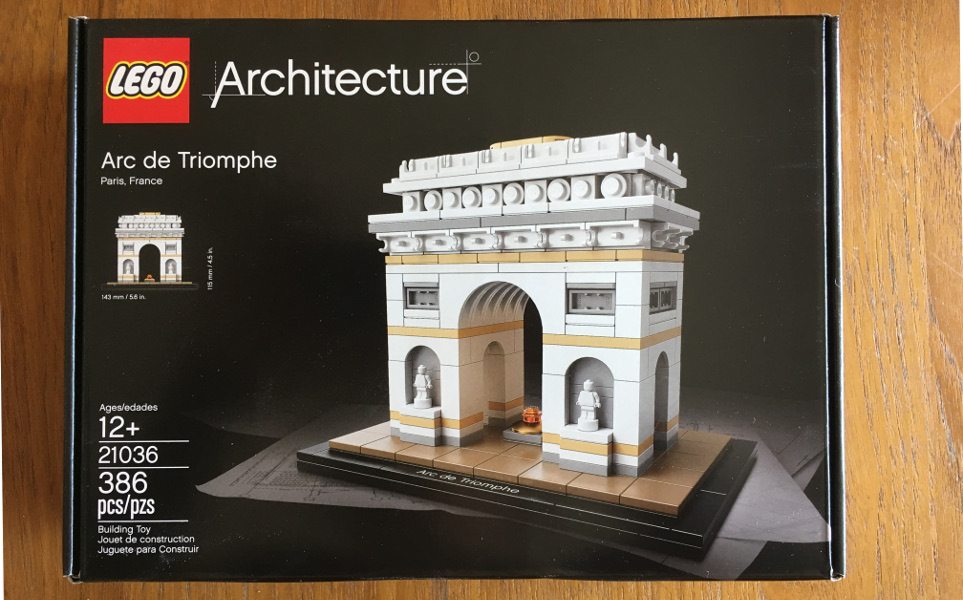
While I’ve technically been to France, it was just a tiny corner of the country during a shortcut from Luxembourg to Germany, so I don’t feel like I’ve really been to France, and certainly not to Paris. But, due to its many museums, historical sites, monuments, and food, it’s high on my list of European travel destinations. For now, though, I’m contenting myself with one of the many visual symbols of France’s capital, the Arc de Triomphe. In LEGO form. Check out my latest stop on the LEGO World Tour.
The Arc de Triomphe
Inside the box for the LEGO Arc de Triomphe—as with all Architecture sets I’ve seen—you receive a nice quality book that includes the history and background of the monument, as well as building instructions. Most of the history is at the beginning of the book, but there are also facts strewn throughout, mingled with the construction steps. The book’s history portions are in English, French, and Spanish. Here’s a bit of what I learned.
The Arc de Triomphe was built between 1806 and 1826. It was first commissioned by Napoleon I to celebrate his military conquests, but after he was defeated in 1814, work on the arch was put on hold. King Louis-Philippe I took up the building again in 1833 to honor those who had fought for France, and the monument is engraved with war victories and generals’ names. There is also an Unknown Soldier from World War I buried beneath the arch, and an eternal flame burns in remembrance of victims of world wars. The arch is modeled after the ancient Roman Arch of Constantine and is located at the western end of the Champs-Élysées, in the Place Charles de Gaulle. It remains the second largest triumphal arch in the world (the largest is the Arch of Triumph in Pyongyang, North Korea).
The Arc de Triomphe is built of white limestone and contains gorgeous reliefs and patterns in its stone façade. The ceiling looks very classical and reminds me of much of the early architecture in Washington, D.C. This is not surprising, as they were constructed during the same time period. The original arch measures 162 feet tall, 150 feet wide, and 72 feet deep. By contrast, the LEGO version measures just over 4 inches high, 5 inches wide, and 3 inches deep, including the base, and is made of plastic.
The Arch in LEGO Form
Though the real-life Arc de Triomphe is much more detailed than the LEGO version, the LEGO designers have worked very hard to capture the textures and feel of the arch. Instead of raised relief groupings, they have tiny minifig statues. Instead of a band of very detailed scenes, they have a different color of brick. They have even added some roof detail (though no telescopes).
Building this kit was great fun, and quite easy. There were a large number of most of the types of pieces, so they were easy to find when digging through the supply. The total number of pieces was large enough to be fun, but small enough to not make it an organizational nightmare. I put each one of the bags’ contents in a separate bowl, and that worked out well.
For this set, LEGO, once again, uses some of their pieces in interesting and unusual ways, making good use of pieces on the façade, along with creating texture. My favorites, though, are the tiny, itty bitty minifig statues. They’re cuter than any LEGO piece I’ve seen in some time. They also include an extra statue in the set (a fifth one) in case you lose one of the other four.
At $39.99 and 386 pieces, the LEGO Arc de Triomphe just barely misses our 10¢ per brick rule, but being that it’s an Architecture set and has included several tiny minifig statues, I’m happy to forgive them. It’s a fun and quick-to-build set (it took me about an hour and a half) that is the perfect gift for yourself, your favorite Francophile, or for those who love world travel. It now sits proudly on a shelf next to my White House and Robie House sets.
Note: I received a set for review purposes.



